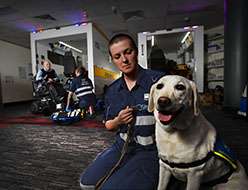Paramedic students learn to interact with patients and their assistance dogs

Paramedics can be faced with multiple situations over the course of any one shift. They have to take on board large amounts of information in a short space of time and make decisions quickly.
One situation they may face is working with assistance dogs when their owner is injured or in need of emergency help, which is why QUT paramedic and nursing students are building capability in working in situations where assistance dogs are present.
QUT paramedic lecturer Stephen Bartlett said assistance dogs were specially trained to help people in their daily lives with a wide range of issues from visual and hearing impairment to adults and children with autism and those experiencing post-traumatic stress disorder.
"Our students are learning how to not only interact with patients but also consider the importance of the involvement of assistance dogs," Mr Bartlett said.
"Assistance dogs are working dogs and they are professionals too so it is vital future paramedics understand the role they play and the relationship they have with their owner.
"Assistance dogs are trained to meet the needs of their particular owner and they can be there to guide and alert as well as fetch objects such as mobile phones, dropped objects out of the reach of their owner and help open doors.
"Some of the professional communication work on the program involves training on how students deal with a situation in which a patient, who is alone except for their assistance dog, needs to be assessed, treated and transported to hospital. "
Mr Bartlett said the Guide, Hearing and Assistance Dogs Act 2009 (Qld) included sections and schedules that detail where guide, hearing and assistance dogs may accompany their owner.
"Assistance dogs cannot access ambulances and in-patient areas of hospitals under the Act.
"This means paramedics must be able to advocate for the dog, a fellow professional, as well as the patient in a real-world situation.
"They must be able to quickly consider the wellbeing of the patient and their dog and find an alternative for the dog, particularly where patients require medical assistance in a public place, such as a concert or sporting event."
Mr Bartlett said 230 students in the paramedic program, many of whom are undertaking a dual degree with nursing, would have opportunity to engage professionally with patients who have assistance dogs as part of their course.
"Representatives from Assistance Dogs Australia and Smart Pups come to campus with their dogs for the students to learn how to handle this complex situation."
Kristy Graham, an assistance dog trainer with Smart Pups which trains dogs for children with special needs such as autism and seizures, said their dogs had access to hospitals with their charges.
"Our dogs are trained to go and lick or nudge an autistic child to interrupt a meltdown which children with autism can be prone to," Ms Graham said.
"Even the dog's presence has a calming effect and often prevents a meltdown.
"Our dogs can also detect when a child is going to have a seizure and they can bark an alert to the parents. They also lie beside the child during the seizure as a comfort for when the child comes out of it and act as a brace to help the child get up off the ground."
Assistance Dogs Australia CEO Richard Lord said assistance dogs were becoming an increasingly popular therapy choice for families.
"We need to make sure that both the general public and employees in all professions are well equipped and can appropriately work with people with an assistance dog," he said.
"With our expansion into newer areas such as autism and post-traumatic stress, we just can't keep up with the demand.
"Last year we placed 26 assistance dogs across Australia, that's one every two weeks."


















